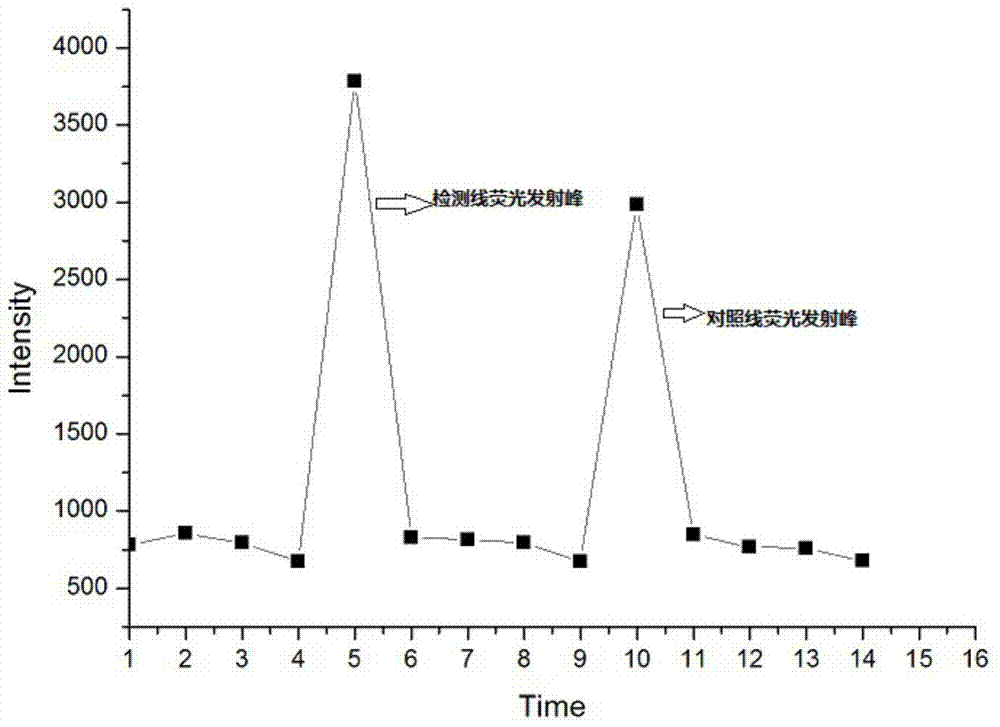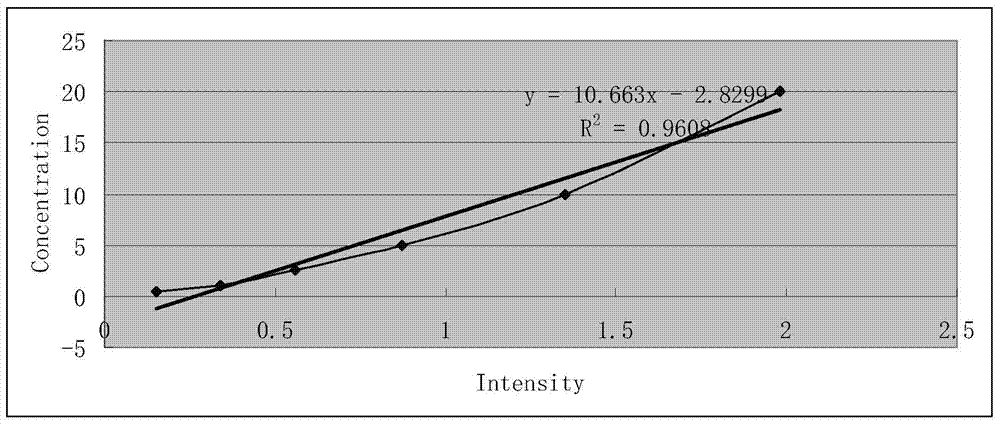Group A rotavirus chromatography test paper strip based on low-noise excitation fluorescent label
A group A rotavirus, fluorescent labeling technology, applied in analytical materials, biological tests, material inspection products, etc., can solve the problem of difficult and rapid quantitative detection of rotavirus, and achieve high signal-to-noise ratio, improved sensitivity, and high detection. The effect of sensitivity
- Summary
- Abstract
- Description
- Claims
- Application Information
AI Technical Summary
Problems solved by technology
Method used
Image
Examples
Embodiment 1
[0041] The group A rotavirus immunochromatographic test strips based on low-noise excitation fluorescent labeling described in this embodiment are as follows: figure 1 As shown, it includes a bottom plate 7 and a sample pad 1, a binding pad 2, an antibody-carrying membrane 3 and a water-absorbent pad 6 that are sequentially adhered to the bottom plate along the length direction of the bottom plate 7, and the sample pad 1 , binding pad 2, antibody-carrying membrane 3 and water-absorbing pad 6, which are sequentially in contact with and only partially overlap adjacent parts; the antibody-carrying membrane 3 is adhered to the middle part of the bottom plate 7, and A quality control line 5 with spaced detection lines 4 is provided, the detection line 4 is close to the binding pad 2 , and the quality control line 5 is close to the water-absorbing pad 6 . The quality control line 4 is arranged parallel to the detection line 5, and the distance between the detection line and the qual...
Embodiment 2
[0056] This embodiment provides a method for qualitatively detecting rotavirus by using the above-mentioned group A rotavirus immunochromatography test strip based on low-noise excitation fluorescent labeling, including the following steps:
[0057] a) Take 25 g of strawberry samples, dilute the samples with 225 mL of PBS buffer solution containing 5% BSA and 0.1% Tween 20, take the supernatant as a test sample, and draw 1 ml of the supernatant for use. Draw 50 μL of the pretreated test sample and drop it on the sample pad 1, after the absorption is dry, add 50 μL of the chromatographic solution dropwise, and take the buffer as a negative control, and use the test strip to perform immunochromatography;
[0058] b) After standing at room temperature for 15 minutes, use a portable low-noise excitation fluorescence scanner (Beijing Borun Fude Technology Development Co., Ltd.) to measure the fluorescence intensity of the detection line and the quality control line area respectively...
Embodiment 3
[0061] This embodiment provides a method for quantitatively detecting rotavirus by using the rotavirus immunochromatography test strip based on low-noise excitation fluorescent labeling.
[0062] (a) Preparation of standard curve: take 100 μg / ml of Group A rotavirus capsid protein (Beijing Huada Protein Company), and dilute the described solution with 5% BSA, 0.1% Tween 20, and PBS (pH7.2) diluent The protein was serially diluted to make 0.5, 1, 2.5, 5, 10, 20 μg / ml samples.
[0063] (b) Take more than 50 μL of sample and drop it on the sample pad 1. After the sample is absorbed, add 50 μL of chromatographic solution dropwise, let it stand at room temperature for 10 minutes, and put the above test strip into a portable low-noise excitation fluorescence scanner (Beijing Readings in Borun Fude Technology Development Co., Ltd.). The above-mentioned serially diluted rotavirus standard products of group A were detected respectively, and the fluorescence values of the detection l...
PUM
| Property | Measurement | Unit |
|---|---|---|
| emission peak | aaaaa | aaaaa |
| wavelength | aaaaa | aaaaa |
Abstract
Description
Claims
Application Information
 Login to View More
Login to View More - R&D
- Intellectual Property
- Life Sciences
- Materials
- Tech Scout
- Unparalleled Data Quality
- Higher Quality Content
- 60% Fewer Hallucinations
Browse by: Latest US Patents, China's latest patents, Technical Efficacy Thesaurus, Application Domain, Technology Topic, Popular Technical Reports.
© 2025 PatSnap. All rights reserved.Legal|Privacy policy|Modern Slavery Act Transparency Statement|Sitemap|About US| Contact US: help@patsnap.com



